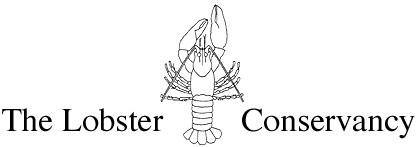
P.O. Box 235, Friendship, ME 04547 (207) 832-8224 www.lobsters.org

P.O. Box 235, Friendship, ME 04547 (207) 832-8224 www.lobsters.org
Summer 2004
Dear Volunteers and Friends of The Lobster Conservancy,
The Lobster Conservancy's mission is to sustain a thriving lobster fishery through science and community. This newsletter keeps our friends and volunteer research team informed of our activities. Here's what we've been up to over the past few months.
News from the Board of Directors
We welcome two new board members, Alice Ingraham of Friendship Long Island and lobsterman Philip Bramhall of Friendship. Alice has long been a supporter of TLC's efforts and brings with her a background in teaching, small business and philanthropy. A Sonar Tracking listener since the project's beginnings in 2002 Philip who is Captain of F/V Amanda Kate and Friendship's fire chief, brings a wide variety of commercial fishing skill and community knowledge to the TLC board. Welcome aboard Alice and Philip!
TLC is happy to announce that Island Institute Fellow, Andrew Mountcastle, will be signing on for another year. To date Andrew has been invaluable to the organization, writing a successful Challenge grant to help renovate Little Morse Island with a new roof and solar power system. Andrew participates as a SCUBA diver for both the Lobster Sonar Tracking Project and Juvenile Lobster Monitoring Program. He also tags and censuses juvenile lobsters at our long-term monitoring site on Friendship Long Island where he is known as “Intertidal Man”. We look forward to his ongoing participation.
Best wishes to Chris Cash who is off to pursue her commercial lobster license by starting the Apprenticeship Program as Robert Bracy's sternman on Monhegan Island this winter. Keep up the lobster conservation!
On a sad note, John Ellis, Sara's father and longtime supporter of TLC, died in July after a victorious battle against cancer. He is dearly missed by friends and family.
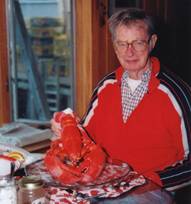
John Ellis loved to eat lobster (Photo by Sara Ellis)
We are pleased to announce several recent grants. Thank you to Northeast Consortium for awarding TLC a third year of funding for our Lobster Sonar Tracking Project. The Lobster Sonar Tracking Project maps the distribution and migratory movements of reproductively active female lobsters. This project is also currently funded by long-time supporters Darden Restaurants, Davis Conservation Foundation, and National Fish and Wildlife Foundation who recently visited with several Congressional Staff members (see below). Massachusetts Environmental Trust has begun to support the Juvenile Lobster Monitoring Program, which has been expanding in Massachusetts over the last few years; support from the MET comes mainly from the sale of the state's environmental license plates.
Our summer appeal is going well. Thank you to all who have answered our plea for financial support. If you didn't receive our appeal letter but would like to, please e-mail sara@lobsters.org.
Research News
Juvenile Lobster Project
Volunteer Project
The 2004 volunteer-based lobster surveys are well underway. Welcome aboard to new volunteers Pine duBois and Sam Partain at TLC's southermost JLMP site in Green Harbor, MA, Tina Beal and Ben Ellis at our northernmost site on Great Wass Island off Jonesport, ME, and Ginny Hopcroft at Gun Point and Tracy Hart at Potts Point in Harpswell, ME. Barbara Melchiskey is now a backup data recorder for Linda Archambault at Allen Island. Sara and Jane have been busy training and certifying our new recruits!
The teams at Waterman's Beach in South Thomaston, Bennett Cove on Chebeague Island, and Drift Inn Beach in Port Clyde have been rewarded for their persistence, as juvenile lobsters have returned in a big way to several of our lowest density sites! Waterman's found 20 lobsters in June, 15 in July, and 16 in August, Bennett Cove 20 in June, 19 in July and 20 in August, and Drift Inn 10 in June, 12 in July and 10 in August. Juvenile lobster abundance recorded at Waterman's and Chebeague during the past three months are five to seven times the average historical abundance at those sites. The reappearance of lobsters at these sites suggests that young lobsters can make larger scale movements than previously thought. Maintaining the long-term sampling studies at low density sites is extremely valuable for our scientific research. Hats off to Leslie Fuller, Annette Naegel, Alfred Petterson, Ben Neal, Julie Wortman, Beth Howe, Mac Passano, and Jim Millinger for their unwavering dedication despite many months sampling without finding many, if any lobsters. For more information on this exciting development, see July's “Ask the Lobster Doc” column in Commercial Fisheries News. A special thanks also to our other volunteers at low density sites at Great Wass, Little Cranberry, and Nahant. The Little Cranberry team scouted a second site in August, due to the scarcity of lobsters at their first site. Going forward, the Little Cranberry team will be sampling at two sites on the island: the Windows and Coast Guard Beach.
June and August yielded higher abundance even to teams accustomed to finding lots of lobsters, with several sites setting new density records. In June, Gerry Island recorded the highest lobster count with 46 lobsters measuring from 9mm to 45mm CL, followed closely by Fort Stark with 40 lobsters, Pratt Island 35, and Plum Cove 31. In July, Fort Stark topped the lobster count finding 34 lobsters ranging from 13mm to 57mm CL, followed by Goose Rocks and Little Harbor with 31, and Broad Cove with 28. Chebeague Island and Kettle Cove found the smallest lobsters in July with a 9mm CL.
The majority of sites have reported their August results. Of the sites that have input their data, Pratt Island found the most lobsters with 56. Other high abundance sites included Gerry Island (43 lobsters), Gun Point (39), Broad Cove (35), Goose Rocks (31), Vinalhaven (30) and Potts Point (27). The smallest lobsters were found at Little Harbor, where Corie Bibber Logan and Pat Masonheimer found 4mm CL postlarval lobsters (the first stage that settles to the bottom)—good eyes! Pratt Island, Gerry Island, and Goose Rocks also found newly settled lobsters.
We are very fortunate to have such a dedicated group of volunteers.
Long-term monitoring at Lowell's Cove
In Diane's 12th year of censusing and tagging juvenile lobsters at Lowell 's Cove it's hard to believe she can still find new things. In August, Diane saw great numbers of postlarvae – the tiny “superlobsters” that settle to the bottom to begin benthic life. Although there was a good range in size of the postlarval stage, many were rather large – probably owing to abundant food in the water column that comes from nutrient rich waters. This rainy year has apparently given the larval lobsters a good boost. Settlement of other benthic organisms has also been strong this year.
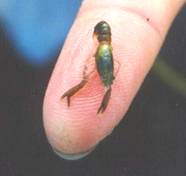
Robust postlarvae have been found at several of our monitoring sites this summer (Photo by Diane Cowan)
In June, Diane found the first juvenile to appear at the site with shell disease. It was a male measuring about 4 inches in overall length. No shell disease has been seen since. The Asian Shore Crabs that had been appearing from time to time haven't been found in well over a year. Overall abundance of juveniles and first year lobsters have been especially high this year as has the rate of recapture of previously tagged juvenile lobsters.
Lobster Life Studies Center
We have recently updated our request for recapture information about lobsters tagged in our Lobster Sonar Tracking Project. If you catch a tagged lobster, please (1) remove the transmitter (sonar tag) and temperature logger, (2) write down where you found it (latitude and longitude as well as local area name), (3) record depth, bottom type and condition of lobster, and (4) call 207-832-8224 so we can let you know how to return the equipment to us and collect your reward. Let us know if you would like a copy of our latest tag return poster by contacting diane@lobsters.org.
We've made some interesting observations on lobster courtship and mating behavior at the lobster pound where we keep approximately 60 male and 240 female lobsters. Although there are 4 times as many females as males in the enclosure, males are usually easier to find. Early this spring, the male lobsters occupied the “mating” shelters before any females could be found and before the lobsters were feeding. Many of the males molted inside of the shelters in early July. The males who did not molt pair bonded with females who moved in, molted and mated with the males throughout July. The females then moved out and are starting to egg out (extrude their eggs onto the underside of the abdomen). Throughout the summer, we set traps in the pound to “inventory” the animals living there and to measure growth and condition since last capture. It is interesting to note that some times of year we catch only males while at other times we catch both males and females. The internal PIT tags we have been using to identify the lobsters have not been retained until lobsters are well above minimum legal size. We are exploring and testing new methods to increase tag retention.
Underwater filmmakers Nick Caloyianis and Clarita Berger have alerted us to an emerging technology that may help us to spy on lobsters in their mating shelters. Engineer Steve Kogge has developed an “underwater endoscopic camera” to study fish hiding in deepwater coral reefs. This tiny camera is bundled at the end of a flexible cable that is only 1-inch in diameter and 3-ft long. The camera sends broadcast-quality video to a digital video recorder via a connecting cable. The recorder and monitor are in a waterproof package about the size of a lunch box, which a diver carries to see what the camera is recording as it explores dark nooks and crannies with its infrared lights. Nick and Clarita brought this camera to Muscongus Bay for some trial runs this summer and we are excited about its potential. This camera allowed us to peer into the mating shelters in the pound.
Lobster Larvae in the Classroom
Grade 6 students at Friendship Village School have become the first graduating class of the Lobster Larvae in the Classroom program. They have participated in the project since its beginnings 2 years ago. They began in the 4th grade by learning basic lobster biology and practicing their scientific observation skills, learned more about the lobster life cycle and marine ecology and became skilled lobster larvae aquaculturists in the 5th grade, and in the 6th grade became researchers and teachers, sharing their own lobster-related projects with younger children at Friendship and Warren schools. A graduation ceremony was held in Carla Eutsler's science classroom on the last day of the project, complete with diplomas and Pomp and Circumstance played by a band with imaginary instruments.
Lobster Learning Center
Island Fellow Andrew Mountcastle has been making fantastic strides on upgrading our Lobster Learning Center on Little Morse Island. Andrew has coordinated many teams of workers to get the job done. A huge thank you to Theresa Torrent Ellis and members of Pen Bay and Midcoast Stewards for their help on Little Morse Island on July 13th. With their help we were able to strip the roof, remove the debris to shore and bring out the new roofing shingles all in one day! They also helped spiff up the floor with a new coat of paint. Thank you to Little Morse Island neighbors Bob and Beverly Souers for multiple donations which included their time, boat, and scaffolding, not to mention their son's expertise in roofing: thanks Kevin! Thanks also to Chris Rock, a new neighbor on Friendship Long Island, for donating time and carpentry skills, and to Tom and Linda Archambault for volunteering their “day off” to the project. The roof is now finished, which could not have happened without Paul Mountcastle, Andrew's brother who donated his time and sense of humor and helped see the project to completion. Thank you Paul and congratulations on your new job as Development Coordinator at Charles River School. Thank you to MBNA for awarding TLC with the Challenge Grant that initiated these upgrades. We still need to raise funds to match the grant from MBNA to help this project go forward, so please help us in any way you can. Our next step is to install a non-polluting, renewable energy source in the form of solar power.
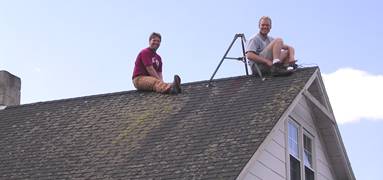
Paul and Andrew Mountcastle reshingling the roof at the Lobster Learning Center (Photo by Sara Ellis)
Presentations and Visitors
MBNA has funded TLC's Lobster Larvae in the Classroom project for the past three years in Friendship, Vinalhaven and Isle au Haut schools. MBNA's Excellence in Education Grants Program receives a large portion of its monies from MBNA employee contributions. On July 15, Linda Archambault and Friendship Village School Science Teacher Carla Eutsler demonstrated the Lobster Larvae project to MBNA employees and their families at the annual company Corn Boil. Adults and children alike were amazed at the tiny size of the 3rd stage larvae and 5th stage juvenile lobsters.
Carla Eutsler demonstrating TLC's Lobster Larvae in the Classroom project (Photo by Linda Archambault)
We were extremely honored to host a book signing of newly published author Trevor Corson as he promoted his book The Secret Life of Lobsters How Fishermen and Scientists Are Unraveling the Mysteries of Our Favorite Crustacean. Around 70 people attended the July 6th event at Hahn Community Center in Friendship to listen to Corson's amusing and knowledgeable presentation which encompassed his own experience as sternman aboard F/V Double Trouble out of Little Cranberry Island to his insight researching Maine scientists Bob Steneck and Diane Cowan and their collaborations with fishermen up and down the coast. It was a thoroughly enjoyable evening. Signed books are still for sale at TLC's office.
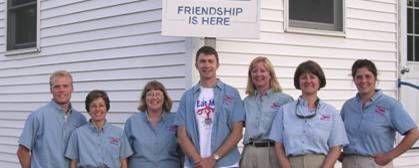
Author Trevor Corson (center) hanging out with staff of The Lobster Conservancy after his book signing in Friendship (Photo by Tom Archambault)
Despite a foggy start, Friendship Day, July 31st, soon turned sunny and warm offering a beautiful day for the community event. TLC again hosted a marine touch tank filled with a variety of sea creatures for young and old to handle and learn about from TLC staff and volunteers. Thank you to Mark Havener for gathering the organisms and to Sarah Havener for helping with all aspects of tank set up, take down and demonstration. A big thank you to Penobscot Marine Museum for their generous supply of Lobstah! tattoos and museum literature. The tattoos were a big success with kids, adults and staff alike. Thank you also to Dot Glazier, Paul Archambault, Mark, Elise and Leslie Wallace for your help with set up and applying those tattoos! After the morning activities Diane and Scott McLeod entertained music fans at the Friendship Museum with a unique blend of voice, guitar and humor.
In July Diane Cowan hosted Richard and Mary Rideout of Bath, Maine for an evening meal on Friendship Long Island and sunset cruise of the harbor. The Rideouts, recipients of our Fishermen Forum Scholarship donation were treated to, what else but, a lobster dinner for two followed by dessert of 3 Berry Pie made from scratch by Dr. Cowan. Yum!
In August, the National Fish and Wildlife Foundation took a contingent of Congressional staff on a trip around Maine to see the kinds of projects that NFWF has been supporting over the years. One of their first stops was the Lobster Life Studies Center where TLC staff gave hands on demonstrations of our research on juvenile and adult lobsters. Thank you to Philip Bramhall for taking the group out on his lobster boat to listen for sonar tagged lobsters.
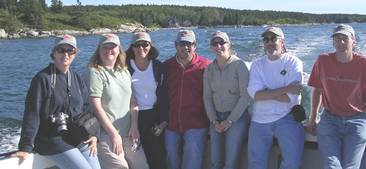
NFWF and Congressional staff visited the Lobster Life Studies Center to learn firsthand about TLC's research (Photo by Sara Ellis)
Press Coverage
Stay tuned: TLC will be featured on CBS Sunday Morning, a popular weekly show watched by some 14 million viewers. The crew came out this spring with writer Trevor Corson to film Diane Cowan and Linda Archambault diving in the Friendship Long Island lobster pound. They also filmed volunteers Seth Barker, Mike and Ann Grimes, Enid Johnson, Leigh and Kit Sherrill, and Dick and Jeanne Whittier surveying for juvenile lobster on Pratt Island in Southport. We'll let you know when the piece is going to air.
Diane was one of the individuals featured in a booklet by the Natural Resources Council of Maine entitled “Global Warming in Maine: Warning Signs, and Winning Solutions”.
Since our last newsletter you can now read three more editions of “Ask the Lobster Doc” online. In July, Sara Ellis was guest columnist writing about TLC volunteers censusing a record number of juvenile lobsters. In August, Diane started a series on lobster landings. Thanks as usual to Commercial Fisheries News for allowing us to reprint Lobster Doc columns. Printable PDF versions of Lobster Doc columns complete with photos are available by request, so please contact us by e-mail or call anytime. Kudos for Lob Docs layout designs belong to Keith Kastelic of CFN.
Announcements
Do you have a few hours to spare from time to time? Are you looking for a way to invest in your community, do work that you can feel good about, and have a few laughs while you're at it? The Lobster Conservancy seeks an office volunteer to help us with a variety of administrative tasks, including scientific data entry and proofreading, maintaining our membership database, and answering phones. Please contact Sara for more information.
Be well, do good work and eat lobster!
Yours in TLC and Friendship,
Sara Ellis, Executive Director and Diane Cowan, Senior Scientist